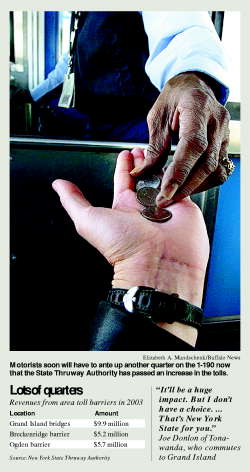Taking its toll
The hike in Thruway fees causes resentment - and resignation - among commuters, taxi drivers and business owners
By MATT GLYNN
News Business Reporter
4/28/2005
The president of Yellow and Liberty Cab says the 25-cent increase in tolls to enter downtown might be passed on to customers.
And a downtown property owner said he will go to court to try to get the Breckenridge and Ogden toll barriers, denounced by critics as a "commuter tax," removed. Those are some of the responses from the business community to the New York State Thruway Authority's plan to raise tolls at the downtown barriers in mid-May. The hikes are part of a larger plan that will see passenger car tolls on the Thruway system rise an average of 25 percent, while commercial tolls will go up about 35 percent.
The toll increases come at a time when motorists are already feeling the pinch from higher gas prices.
At the local toll booths, passenger cars without E-ZPass will pay 75 cents, instead of the current 50 cents. The same tolls apply at the Grand Island bridges.
Tim Herzog, Flying Bison's president, estimates his business already spends about $15 per week on local highway tolls. He said his company will just have to eat the latest increase.
"It's something else that small businesses have to absorb," Herzog said.
William Yuhnke, president of Yellow and Liberty Cab, said he is exploring whether he needs Common Council approval to pass a 25-cent toll increase on to customers.
Otherwise, he said, the higher toll will affect taxi drivers' finances. "Here's one more added expense that has to come out of their pocket," he said.
Carl P. Paladino, a prominent downtown property owner, plans to fight the toll hike. He has retained a lawyer to begin a legal battle.
"You can enter Rochester, Syracuse and Albany on free roads, but you have to pay to enter Buffalo. It's not only wrong, I believe it's illegal," Paladino said.
He noted that the I-190, which passes through downtown Buffalo and serves as a key city artery, is the only tributary to the mainline Thruway where motorists are required to pay tolls.
Paladino announced his planned suit at a Wednesday meeting of Buffalo Place, a not-for-profit advocacy group that has long called for removal of the tolls.
"I'm going to join Carl in this lawsuit," said Mayor Anthony M. Masiello. "The tolls discourage people from entering Buffalo and put us at a disadvantage."
The mayor said it is time to rachet up the anti-toll fight from words to actions. "We need to get more aggressive and "in your face,' " he said.
Tolls a disadvantage
Thruway representatives declined to comment on the
threatened lawsuit. In the past, the authority has argued that the Buffalo
tolls are necessary to pay for upkeep of the I-190, and that without them
taxes would skyrocket. State lawmakers from Buffalo Niagara have sought to
remove the downtown tolls, without success.
The Breckenridge and Ogden toll barriers collected a combined $10.9 million in revenue in 2003, according to the latest available figures from the Thruway Authority. The Grand Island bridges collected about $10 million in 2003, bringing combined revenues collected at the four local barriers to about $21 million.
Paladino's threatened suit echoes Buffalo Place's position that the tolls are a competitive disadvantage for downtown businesses.
"What's particularly disappointing is, we don't get much from that commuter tax," said Keith Belanger, Buffalo Place's chairman and an M&T Bank executive.
Does he see the higher toll as an impediment to businesses locating downtown? "It certainly doesn't help," he said.
A Thruway Authority study just getting underway will explore reducing the number of toll collection points to modernize the system. Buffalo Place is hopeful that could lead to the abolition of the downtown tolls several years from now, said Debra Chernoff, manager of planning for Buffalo Place.
Andrew Rudnick, president of the Buffalo Niagara Partnership, said he believes the Niagara Thruway tolls also affect commuters who drive to the suburbs for their jobs, not just downtown businesses.
"One of our strengths is our accessibility. It's quick and inexpensive to move from one place to another," Rudnick said. "I think the toll barriers get in the way of that."
But as the toll hikes go into effect, Rudnick hopes the Thruway Authority's new plans will support a more advanced E-ZPass system that will speed motorists' trips, and, ultimately, lead to the removal of one or more of the toll barriers. "You've got to keep pushing for it," Rudnick said.
Tony McKenna, chairman of the Partnership's Transportation Committee, said the committee has told Thruway officials that "this commuter tax issue isn't going to go away."
Impact unknown
McKenna said that maintaining the area's transportation
infrastructure is crucial to the area's economy. But he said it's also
important that the additional revenues are used to bolster the E-ZPass
system, and that the authority keep its administrative costs low.
The higher toll also arrives as downtown prepares for new development, including a Bass Pro store and a new headquarters for HealthNow New York, the parent company of Blue Cross Blue Shield of Western New York.
The new HealthNow offices are set to open in 2007 on West Genesee Street, next to the Niagara Thruway. But spokeswoman Laura Perry said it was premature to speculate on the impact that higher tolls might have on HealthNow's work force after the offices relocate there.
For drivers with E-ZPass, the cost to pass through one of the toll barriers will rise to 68 cents instead of the full 75 cents. And the Thruway Authority says a commuter rate program, like the one used on Grand Island, will be offered at the Breckenridge and Ogden barriers. Drivers will still pay only 50 cents, if they make 20 trips per month through the barrier.
Trucks equipped with E-ZPass will see a 5 percent discount on their new rates, and the Thruway Authority says trucks will also be eligible for volume discounts.
Businesses such as Try-It Distributing Co., which ships beverages around Erie and Niagara counties, welcome any chance to reduce their toll bills.
Paul Vukelic, president and chief operating officer, said his company spent $6,800 on tolls last year. A 35 percent toll increase would cost his company nearly $9,200.
Try-It's trucks use E-ZPass, so that should provide some savings, Vukelic said. But, he added, "any increase is not good for our business."
While downtown is bracing for higher tolls, trips over the Grand Island bridges will also get more expensive.
Adapting to change
Natalie Zuccari, a Town of Wheatfield resident, drives
through Grand Island to get to her job at Buffalo General Hospital. She
plans to take another route: through North Tonawanda and the Town of
Tonawanda.
"I think that's a lot of money to raise it, (by) a whole quarter," the 26-year-old said. "If they want to raise it, it should be a nickel or 10 cents. I probably won't spend that much. It adds up pretty quickly."
Joe Donlon, 27, who lives in the Town of Tonawanda but works on Grand Island, doesn't have an alternate route to get to his job. "It'll be a huge impact," he said. "But I don't have a choice. It's like gasoline, you need to do it. You kind of adapt to the change. It doesn't make anybody happy. It's a shame - that's New York State for you."

